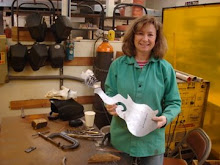Relate one thing from the reading to your everyday world.
The one section of this chapter that really spoke to me was the section that talked about fiber arts, as I enjoy working in this medium. The tapestries of the 15th century served many purposes- they told stories, as seen in the Hunt for the Unicorn series, they were a symbol of wealth, they provided beautiful decorations, and they provided insulation from the cold in those stone houses and castles of the time. I have seen some of these tapestries in castles in England, in museums in Europe, and in the Vatican in Rome. They are extremely large and incredibly intricate. What is so impressive about tapestry as an art form is how they are made. When you paint a picture, you can work at any point on the canvas. You can start and stop. You can go in and redo a section that you don’t like, by painting over it. But with a tapestry, you have to plan out the whole picture down to the smallest detail ahead of time. Then you have to weave row after row of colored yarn starting with the first row on the bottom and working your way up to the top, row by row. For example, with the making of the “Unicorn is found at the Fountain”, you would have to know that in row 56 (just choosing one at random) , you have to make over 100 color changes to create the background, leaves, legs and body parts of the various animals, flower petals, oranges, lions paws and tail, foreground, and the hidden letters representing the patrons. And after completing that row, you would have to start all over again with row 57 and onward!!
This fascinates me because I like to make art quilts. I use fabric that I have applied fusible webbing to the back of, and with many different colors, I create scenes or abstract pictures. After creating the top, I sew all the pie
 ces in place with a multitude of colorful threads, varying the length and the type of stitch to make a unique design. Like the tapestries of the 15th century, I use many different threads to create a complete piece. My quilts are very basic when compared to the Tapestries of the 15th century, but I am inspired by them and hope to attain some of their eye for detail in my future projects!
ces in place with a multitude of colorful threads, varying the length and the type of stitch to make a unique design. Like the tapestries of the 15th century, I use many different threads to create a complete piece. My quilts are very basic when compared to the Tapestries of the 15th century, but I am inspired by them and hope to attain some of their eye for detail in my future projects!(Some of my art quilts...)
 (The detail of the stitching of my "Afternoon in Maui" quilt)
(The detail of the stitching of my "Afternoon in Maui" quilt)


Kimberlie,
ReplyDeleteThanks for pointing out that there is no doing things over when it comes to a tapestry. When painting I'm sure it's easy to correct by painting it over but how do you rip out a tapestry? This makes this type of art so much more impressive.
I really enjoyed your insight in regards to working with Fiber. The way you explained how difficult the tapestry process is brought an entire new respect to the way I will view tapestry from this day forward. I also like how you mentioned that tapestry has a double meaning within the content of its essence. Tapestry, also served as a catalyst to shield families from the cold, a protector of warmth within the stoned walls.
ReplyDeletewow, your quilts are truely beautiful! so intricate & full of life
ReplyDeletethank you for sharing them with us & writting such an insightful & detailed explanation of fiber arts. I had written an entry about tapestries too.
your last one at the bottom reminds me of Eric Cole's art, how he uses cut outs of different textures & colors & puts them together to create a wonderful collage..and your quilts are not basic!
great job kimberlie.. & good luck with your statue in the making :)